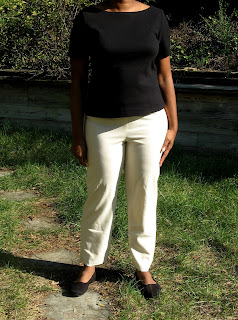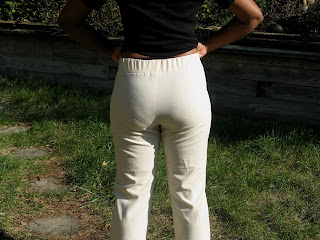Pattern Description: Long sleeve top with front neckline twist, dropped shoulders, and stitched hem.
Pattern Sizing: Size BB (8-10-12-14) I made a size 8 after noting when I made it before that the pattern ran large.
Did it look like the photo/drawing on the pattern envelope once you were done sewing with it? Not really, as it was not as fitted as the illustration would have you believe.
Were the instructions easy to follow? Yes, very.
 What did you particularly like or dislike about the pattern? I was intrigued by the twist detail at the center front. I liked the idea of a very simple top but with interest. However, when I made the pattern the first time I found the pattern illustration deceiving. The top did not have a close fit at the waist, in fact, it resembled a square with no waist shaping.
What did you particularly like or dislike about the pattern? I was intrigued by the twist detail at the center front. I liked the idea of a very simple top but with interest. However, when I made the pattern the first time I found the pattern illustration deceiving. The top did not have a close fit at the waist, in fact, it resembled a square with no waist shaping.
Fabric Used: Ponteroma knit in Winter White for $3 per yard (orig $15) from Hancock Fabrics liquidation sale.
Pattern Alterations or any design changes you made: Because I have made this before, I used a altered pattern closer to a size 8, actually two sizes smaller than the pattern would have me make according to my measurements. However, since I was also making this in a stable ponte instead of cotton jersey like the last top I added 1/4" to each width-wise seam when I cut it out.
This is the second time that I've made this top so I have an adjusted pattern now. However, if you are working from the original you may wish to remove some of that extra fabric hanging beneath the twist. I suggest you scoop out the front seam, curving in from the bottom of the open twist to one inch at the middle and and then back out to the hem, blending out to the original seam.
I found it much easier to hand stitch the twist loop edges because they would show when wearing.
Would you sew it again? Would you recommend it to others? Yes, with my adapted pattern this is now one of my TNT patterns. I have now made it in three different fabrics; nylon/spandex blend, cotton jersey, and ponte. I still recommend it to others because of the design but strongly suggest that a muslin be made first.
This is the second time that I've made this top so I have an adjusted pattern now. However, if you are working from the original you may wish to remove some of that extra fabric hanging beneath the twist. I suggest you scoop out the front seam, curving in from the bottom of the open twist to one inch at the middle and and then back out to the hem, blending out to the original seam.
I found it much easier to hand stitch the twist loop edges because they would show when wearing.
Would you sew it again? Would you recommend it to others? Yes, with my adapted pattern this is now one of my TNT patterns. I have now made it in three different fabrics; nylon/spandex blend, cotton jersey, and ponte. I still recommend it to others because of the design but strongly suggest that a muslin be made first.


















































